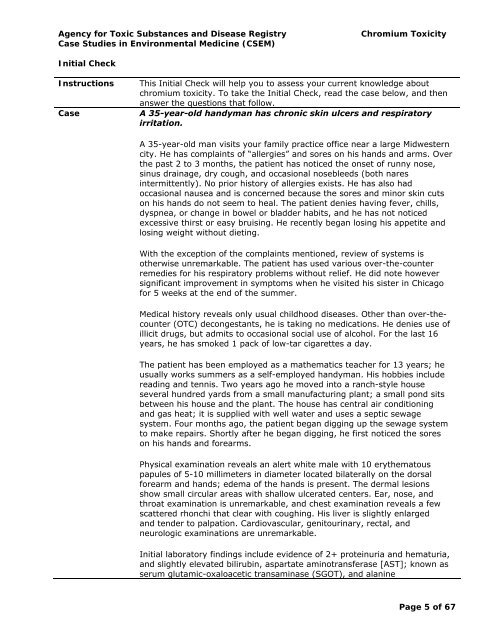(Cr) Toxicity | ATSDR - CSEM - Agency for Toxic Substances and ...
(Cr) Toxicity | ATSDR - CSEM - Agency for Toxic Substances and ...
(Cr) Toxicity | ATSDR - CSEM - Agency for Toxic Substances and ...
Create successful ePaper yourself
Turn your PDF publications into a flip-book with our unique Google optimized e-Paper software.
<strong>Agency</strong> <strong>for</strong> <strong>Toxic</strong> <strong>Substances</strong> <strong>and</strong> Disease Registry Chromium <strong><strong>Toxic</strong>ity</strong><br />
Case Studies in Environmental Medicine (<strong>CSEM</strong>)<br />
Initial Check<br />
Instructions This Initial Check will help you to assess your current knowledge about<br />
chromium toxicity. To take the Initial Check, read the case below, <strong>and</strong> then<br />
answer the questions that follow.<br />
Case A 35-year-old h<strong>and</strong>yman has chronic skin ulcers <strong>and</strong> respiratory<br />
irritation.<br />
A 35-year-old man visits your family practice office near a large Midwestern<br />
city. He has complaints of “allergies” <strong>and</strong> sores on his h<strong>and</strong>s <strong>and</strong> arms. Over<br />
the past 2 to 3 months, the patient has noticed the onset of runny nose,<br />
sinus drainage, dry cough, <strong>and</strong> occasional nosebleeds (both nares<br />
intermittently). No prior history of allergies exists. He has also had<br />
occasional nausea <strong>and</strong> is concerned because the sores <strong>and</strong> minor skin cuts<br />
on his h<strong>and</strong>s do not seem to heal. The patient denies having fever, chills,<br />
dyspnea, or change in bowel or bladder habits, <strong>and</strong> he has not noticed<br />
excessive thirst or easy bruising. He recently began losing his appetite <strong>and</strong><br />
losing weight without dieting.<br />
With the exception of the complaints mentioned, review of systems is<br />
otherwise unremarkable. The patient has used various over-the-counter<br />
remedies <strong>for</strong> his respiratory problems without relief. He did note however<br />
significant improvement in symptoms when he visited his sister in Chicago<br />
<strong>for</strong> 5 weeks at the end of the summer.<br />
Medical history reveals only usual childhood diseases. Other than over-thecounter<br />
(OTC) decongestants, he is taking no medications. He denies use of<br />
illicit drugs, but admits to occasional social use of alcohol. For the last 16<br />
years, he has smoked 1 pack of low-tar cigarettes a day.<br />
The patient has been employed as a mathematics teacher <strong>for</strong> 13 years; he<br />
usually works summers as a self-employed h<strong>and</strong>yman. His hobbies include<br />
reading <strong>and</strong> tennis. Two years ago he moved into a ranch-style house<br />
several hundred yards from a small manufacturing plant; a small pond sits<br />
between his house <strong>and</strong> the plant. The house has central air conditioning<br />
<strong>and</strong> gas heat; it is supplied with well water <strong>and</strong> uses a septic sewage<br />
system. Four months ago, the patient began digging up the sewage system<br />
to make repairs. Shortly after he began digging, he first noticed the sores<br />
on his h<strong>and</strong>s <strong>and</strong> <strong>for</strong>earms.<br />
Physical examination reveals an alert white male with 10 erythematous<br />
papules of 5-10 millimeters in diameter located bilaterally on the dorsal<br />
<strong>for</strong>earm <strong>and</strong> h<strong>and</strong>s; edema of the h<strong>and</strong>s is present. The dermal lesions<br />
show small circular areas with shallow ulcerated centers. Ear, nose, <strong>and</strong><br />
throat examination is unremarkable, <strong>and</strong> chest examination reveals a few<br />
scattered rhonchi that clear with coughing. His liver is slightly enlarged<br />
<strong>and</strong> tender to palpation. Cardiovascular, genitourinary, rectal, <strong>and</strong><br />
neurologic examinations are unremarkable.<br />
Initial laboratory findings include evidence of 2+ proteinuria <strong>and</strong> hematuria,<br />
<strong>and</strong> slightly elevated bilirubin, aspartate aminotransferase [AST]; known as<br />
serum glutamic-oxaloacetic transaminase (SGOT), <strong>and</strong> alanine<br />
Page 5 of 67

















